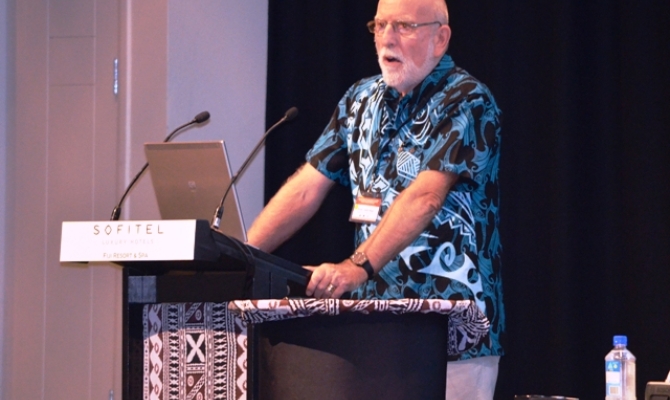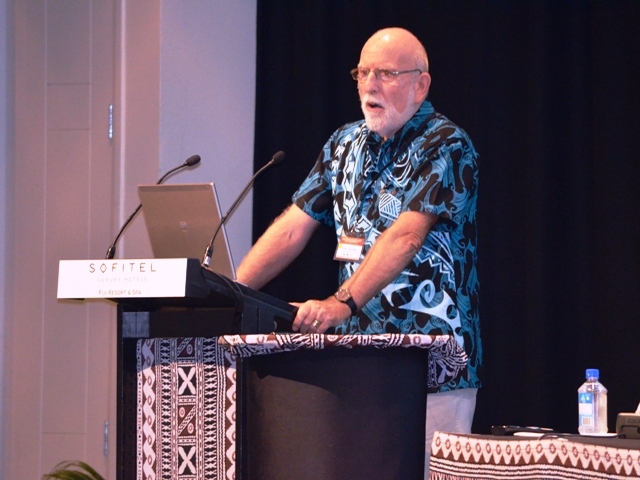
Climate Change Resilience
10 July 2013, Nadi, Fiji - Pacific Island Governments have been urged to insist that climate resilience be built into major infrastructure projects funded by development partners.
Professor John Hay, an AusAID consultant has just completed studies into two infrastructure projects in Samoa and Cook Islands.

In both cases C the re-development of the Samoan Parliament complex and the Avatiu Harbour in Cook Islands, the climate proofing costs are minimal.
"In Samoa's case, climate proofing is less than five percent of the total cost of the project. One of the things coming out of our study now is that addressing these climate and disaster risks to infrastructure does not add a huge amount of cost to building new infrastructure or improving existing infrastructure.
The climate resilience cost for the Avatiu wharf was NZ$500,000, said Professor Hay.
Proposed changes to the Samoan Parliament complex to be funded at a cost of AUD$17 million by AusAID will have climate resilience built into it, based on the work carried out by Professor Hay.
"My advice to the government of Samoa was that there was extreme risk of tropical cyclone induced storm surge where the current complex stood. This is the major hazard that will test the building to the extreme in the next 50 years.
The Samoan Government was given two options C to protect the site through mangrove vegetation and to raise the building on a platform.
"The option that the Samoan Government has chosen is to raise the ground surface and then construct the Parliament building on this high level. What we found was that in terms of the costs, this is more cost effective than protecting the site, explained Professor Hay.
For Avatiu Harbour, storm surge, which is damaging the wharf building, was identified as a major issue that needed climate proofing.
"In the new design, they have raised the level of the wharf and the container storage area to take into account the projected higher sea level expected in the future and strengthened the foundation of the whole harbour to accommodate these very strong waves that potentially could destroy the structure.
Learning from the experiences of Samoa and Cook Islands, Professor Hay reiterated the need for governments to insist on climate resilience infrastructure that will withstand the impacts of climate change and disasters for the next 50 years.
"We want governments to have a strong resilient infrastructure. If that infrastructure fails, everyone is affected. Making sure that infrastructure is resilient is a responsibility of the government on behalf of its people, said Professor Hay.
The proposed redevelopment of the Samoan Parliament House is a 50 years gift from the government of Australia to the people of Samoa.
The Joint Meeting of the Pacific Platform for Disaster Risk Management and the Pacific Climate Change Roundtable is from 8 C 11 July and is jointly organised by the Secretariat of the Pacific Community, the United Nations Office for Disaster Risk Reduction and the Secretariat of the Pacific Regional Environment Programme. The meeting is hosted by the Government of Fiji.
Professor John Hay, an AusAID consultant has just completed studies into two infrastructure projects in Samoa and Cook Islands.

In both cases C the re-development of the Samoan Parliament complex and the Avatiu Harbour in Cook Islands, the climate proofing costs are minimal.
"In Samoa's case, climate proofing is less than five percent of the total cost of the project. One of the things coming out of our study now is that addressing these climate and disaster risks to infrastructure does not add a huge amount of cost to building new infrastructure or improving existing infrastructure.
The climate resilience cost for the Avatiu wharf was NZ$500,000, said Professor Hay.
Proposed changes to the Samoan Parliament complex to be funded at a cost of AUD$17 million by AusAID will have climate resilience built into it, based on the work carried out by Professor Hay.
"My advice to the government of Samoa was that there was extreme risk of tropical cyclone induced storm surge where the current complex stood. This is the major hazard that will test the building to the extreme in the next 50 years.
The Samoan Government was given two options C to protect the site through mangrove vegetation and to raise the building on a platform.
"The option that the Samoan Government has chosen is to raise the ground surface and then construct the Parliament building on this high level. What we found was that in terms of the costs, this is more cost effective than protecting the site, explained Professor Hay.
For Avatiu Harbour, storm surge, which is damaging the wharf building, was identified as a major issue that needed climate proofing.
"In the new design, they have raised the level of the wharf and the container storage area to take into account the projected higher sea level expected in the future and strengthened the foundation of the whole harbour to accommodate these very strong waves that potentially could destroy the structure.
Learning from the experiences of Samoa and Cook Islands, Professor Hay reiterated the need for governments to insist on climate resilience infrastructure that will withstand the impacts of climate change and disasters for the next 50 years.
"We want governments to have a strong resilient infrastructure. If that infrastructure fails, everyone is affected. Making sure that infrastructure is resilient is a responsibility of the government on behalf of its people, said Professor Hay.
The proposed redevelopment of the Samoan Parliament House is a 50 years gift from the government of Australia to the people of Samoa.
The Joint Meeting of the Pacific Platform for Disaster Risk Management and the Pacific Climate Change Roundtable is from 8 C 11 July and is jointly organised by the Secretariat of the Pacific Community, the United Nations Office for Disaster Risk Reduction and the Secretariat of the Pacific Regional Environment Programme. The meeting is hosted by the Government of Fiji.